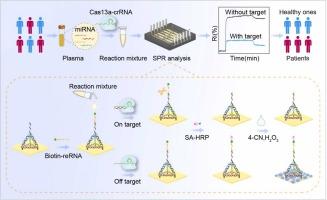crispr介导的三维纳米结构表面等离子体共振成像生物传感器,用于高灵敏度的microRNA检测
IF 3.7
1区 化学
Q1 CHEMISTRY, ANALYTICAL
引用次数: 0
摘要
MicroRNA(miRNA)已成为阿尔茨海默病(AD)早期诊断的一种特别有前途的生物标志物。然而,目前的miRNA检测方法在灵敏度和预扩增步骤方面仍然存在挑战。本研究提出了一种新型表面等离子体共振成像(SPRi)生物传感器,将基于四面体DNA纳米结构(TDN)的表面组织与crispr - cas13a介导的分子识别相结合,实现了ad相关miRNA-137的无扩增、敏感和特异性检测。生物素标记的RNA报告子固定在金膜表面的TDN框架上,确保探针的方向。在目标miRNA-137存在的情况下,CRISPR-Cas13a系统激活、切割这些报告基因,并阻止随后链亲和素hrp的结合,从而抑制酶促反应的沉淀形成。在最佳条件下,该传感器与自主开发的高灵敏度调强SPRi系统集成,对miRNA-137在0.5 pM ~ 500 nM范围内具有良好的线性响应,检测限为212 fM。该平台鉴别单碱基突变具有良好的特异性,对临床血浆样品具有可靠的分析能力。值得注意的是,我们的传感器证实,与健康人相比,AD患者的miRNA-137水平显著降低。这种创新的检测方法为AD相关mirna的检测提供了强有力的工具,有望推进AD的早期诊断研究。本文章由计算机程序翻译,如有差异,请以英文原文为准。

CRISPR-mediated 3D nanostructured surface plasmon resonance imaging biosensor for highly sensitive microRNA detection
MicroRNA(miRNA) has emerged as a particularly promising biomarker for the early diagnosis of Alzheimer's disease (AD). However, current detection methods for miRNA remain challenges in terms of sensitivity and pre-amplification steps. This study proposes a novel surface plasmon resonance imaging (SPRi) biosensor that combines tetrahedral DNA nanostructures (TDN)-based surface organization with CRISPR-Cas13a-mediated molecular recognition, enabling amplification-free, sensitive, and specific detection of AD-related miRNA-137. The biotin-labeled RNA reporters are anchored to TDN framework on the gold film surface, ensuring the orientation of the probe. In the presence of target miRNA-137, the CRISPR-Cas13a system activates, cleaves these reporters and prevents subsequent binding of streptavidin-HRP, thereby inhibiting precipitate formation from the enzymatic reaction. Under optimal condition, this sensor, integrated with the self-developed highly sensitive intensity-modulated SPRi system, displays a good linear response to miRNA-137 ranging from 0.5 pM to 500 nM with a detection limit of 212 fM. The platform demonstrates excellent specificity of discriminating single-base mutation, and reliable analysis capability in clinical plasma samples. Notably, our sensor confirms significantly reduced miRNA-137 levels in AD patients compared to healthy people. This innovative assay provides a powerful tool for the detection of AD-related miRNAs, promising to advance early diagnosis research for AD.
求助全文
通过发布文献求助,成功后即可免费获取论文全文。
去求助
来源期刊

Sensors and Actuators B: Chemical
工程技术-电化学
CiteScore
14.60
自引率
11.90%
发文量
1776
审稿时长
3.2 months
期刊介绍:
Sensors & Actuators, B: Chemical is an international journal focused on the research and development of chemical transducers. It covers chemical sensors and biosensors, chemical actuators, and analytical microsystems. The journal is interdisciplinary, aiming to publish original works showcasing substantial advancements beyond the current state of the art in these fields, with practical applicability to solving meaningful analytical problems. Review articles are accepted by invitation from an Editor of the journal.
 求助内容:
求助内容: 应助结果提醒方式:
应助结果提醒方式:


